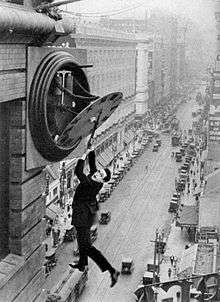Silent comedy

Silent comedy is a style of film, related to but distinct from mime, invented to bring comedy into the medium of film in the silent film era (1900s–1920s) before a synchronized soundtrack which could include talking was technologically available for the majority of films. Silent comedy is still practiced, albeit much less frequently, and it has influenced comedy in modern media as well.
Silent comedies often place heavy emphasis on visual and physical humors, often including "sight gags", to tell stories and entertain the viewer. Many of these physical gags are exaggerated forms of violence which came to be called "slapstick". The "prat fall", slipping on a banana peel, getting soaked with water, and getting a pie thrown in one's face are all classic examples of slapstick comedy devices.
Silent film era
The first silent comedy film is generally regarded as L'Arroseur Arrosé, directed and produced by Louis Lumière. Shown to the public on July 10, 1895, it ran for 49 seconds and consisted of a gardener being sprayed in the face with a hose. While it did not run for long, L'Arroseur Arrosé created a new genre and inspired its audiences.[1]
Intertitles almost always served the purpose of introducing characters and setting. Intertitles also often conveyed dialogue. Occasionally these intertitles included illustrations, but most often they were black with white text. Conversation could also be shown using body language and mouthing. Color silent films are quite rare, as inexpensive color film was not invented until the late 1930s; the vast majority of silent comedies are in black and white. Seven Chances is an exception, with opening scenes filmed in early Technicolor.
Mack Sennett and Hal Roach were two of the most famous producers of silent comedies. Famous actors and teams from this era are now legendary: Ben Turpin, Keystone Cops, Mabel Normand, Edna Purviance, Roscoe "Fatty" Arbuckle, Charlie Chaplin, Buster Keaton, Harold Lloyd, Harry Langdon, Charley Chase, Stan Laurel (who made a commercially successful transition into talking pictures in the team Laurel & Hardy), along with many others.
Modern era
In the early years of "talkie" films (beginning in 1927, see The Jazz Singer) a few actors continued to act silently for comedic effect, most famously Charlie Chaplin, whose last great "silent" comedies City Lights (1931) and Modern Times (1936) were both made in the sound age. Another late example was Harpo Marx, who always played a mute in the Marx Brothers' films.
Another important legacy of silent film comedy was the humor in animated cartoons. Even as live-action comedy moved towards a focus on the verbal humor of Abbott and Costello and Groucho Marx, animated cartoons took up the entire range of slapstick gags, frenetic chase scenes, visual puns, and exaggerated facial expressions previously seen in silent comedies. These devices were most pronounced in the Looney Tunes and Merry Melodies cartoons from Warner Bros. directed by Bob Clampett, Chuck Jones and Friz Freleng and in the MGM Cartoons of Tex Avery and the "Tom and Jerry" cartoons of William Hanna and Joseph Barbera.
An early television series that featured exaggerated visual humor was the Ernie Kovacs program.
During the 1960s and 1970s, several films made homages or references to the silent era of film comedy. It's a Mad, Mad, Mad, Mad World performers and gags form the era and Blake Edwards' The Great Race and Mel Brooks' Silent Movie were full-length tributes. Peter Bogdanovich's What's Up, Doc? also featured slapstick gags and Keystone-style chase scenes, ideas that prefigured much of the humor in The Blues Brothers and Airplane! later in the decade.
An episode of The Brady Bunch featured the family making a silent comedy filled with pie-throwing.
Few feature films today exploit the genre of silent comedy. Occasionally, comedy teams will use a silent character for comedic effect. The most consistent—and also the most famous—is Teller from Penn & Teller.
Rowan Atkinson had huge success in the 1990s with the character Mr. Bean.
Shaun the Sheep is a British stop motion animated children's television series which also uses silent comedy.
However, techniques employed by silent comedy, continue to influence talkie comedies, mainly through silent comedy's development of the older art of slapstick and through artistic reference to the trademark gags of famous silent comedians. In 2010, India's first silent comedy series, Gutur Gu (2010) started SAB TV, and became a hit.[2][3]
References
- ↑ http://www.filmreference.com/Films-Am-Aw/L-Arroseur-Arrose.html
- ↑ "Fans love Gutur Gu cast". The Times of India. Mar 12, 2011.
- ↑ "Hush: Gutur Gu, India's first silent comedy show, goes on air from March 5". Indian Express. Mar 7, 2010.
Further reading
- Kerr, Walter (1975). The Silent Clowns. New York: Alfred A. Knopf. ISBN 0-394-46907-0.